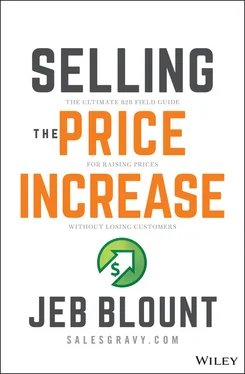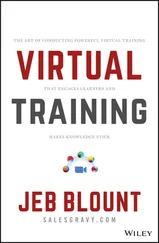Jeb Blount - Selling the Price Increase
Здесь есть возможность читать онлайн «Jeb Blount - Selling the Price Increase» — ознакомительный отрывок электронной книги совершенно бесплатно, а после прочтения отрывка купить полную версию. В некоторых случаях можно слушать аудио, скачать через торрент в формате fb2 и присутствует краткое содержание. Жанр: marketing, на английском языке. Описание произведения, (предисловие) а так же отзывы посетителей доступны на портале библиотеки ЛибКат.
- Название:Selling the Price Increase
- Автор:
- Жанр:
- Год:неизвестен
- ISBN:нет данных
- Рейтинг книги:5 / 5. Голосов: 1
-
Избранное:Добавить в избранное
- Отзывы:
-
Ваша оценка:
- 100
- 1
- 2
- 3
- 4
- 5
Selling the Price Increase: краткое содержание, описание и аннотация
Предлагаем к чтению аннотацию, описание, краткое содержание или предисловие (зависит от того, что написал сам автор книги «Selling the Price Increase»). Если вы не нашли необходимую информацию о книге — напишите в комментариях, мы постараемся отыскать её.
Selling the Price Increase: The Ultimate B2B Field Guide for Raising Prices Without Losing Customers
Selling the Price Increase
broad-based, targeted, non-negotiable, negotiable, defending, presenting,
asking
Virtual Selling
Selling the Price Increase
Selling the Price Increase — читать онлайн ознакомительный отрывок
Ниже представлен текст книги, разбитый по страницам. Система сохранения места последней прочитанной страницы, позволяет с удобством читать онлайн бесплатно книгу «Selling the Price Increase», без необходимости каждый раз заново искать на чём Вы остановились. Поставьте закладку, и сможете в любой момент перейти на страницу, на которой закончили чтение.
Интервал:
Закладка:
Format
Within these initiatives, price increases may be applied in a unit-based format to individual line items, which is typical for physical products, or a broad-based format on the entire account's billing, which is typical for services.
Challenges
As sales and service professionals, we all face different challenges with selling price increases to our customer base. If you didn't have challenges, it is unlikely that you would be reading this book.
These challenges are often unique to your industry, product or service, account sizes and types, stakeholder relationships, competitors, and region, and the various scenarios listed above.
In sales and customer service, there are few one-size-fits-all solutions or applications. Therefore, as you advance through the lessons in this book, use your unique challenges as a guide to inform where you need to place the most attention, what you need to adjust for your specific situation, the ideas and lessons you take with you, and what you leave behind.
In the remainder of Part One, we'll focus on techniques for rising above fear and the emotional hang-ups that create anxiety and hold you back from effectively selling price increases. A key takeaway from this section – and one that will be repeated often throughout the book – is:
1 In every price increase conversation, the person who exerts the greatest emotional control has the highest probability of achieving their desired outcome.
Before we get started, I want you to take a moment to complete this short exercise on price increase challenges.
Exercise 1.1 Price Increase Challenges
Reflect on past experiences with selling price increases, as well as immediate concerns about pending price increase initiatives and conversations.
List what you feel are your biggest challenges with presenting, defending, and negotiating pricing increases.
Leadership and Coaching Pro Tip
Bringing Challenges to the Surface
Price increase initiative roll outs naturally induce anxiety among your team members. Immediately they'll begin to worry and play the worst case scenarios in their heads.
An easy exercise to help bring their concerns and fears to the surface is to break them into small groups and have them list what they feel will be their biggest challenges with selling the price increase.
Once your team begins talking about their challenges, it will naturally help dial back anxiety levels and reduce their fears. They'll vent, learn from each other, and share best practices.
Importantly, the discussion will help you focus your training and coaching on the areas that will help your team perform at a high level.
Notes
1 1. Michael V. Marn and Robert L. Rosiello, “Managing Price, Gaining Profit,” Harvard Business Review, September–October 1992. https://hbr.org/1992/09/managing-price-gaining-profit.
2 2. Stephen Mewborn, Justin Murphy, and Glen Williams. “Clearing the Roadblocks to Better B2B Pricing,” Bain & Company, December 10, 2014. https://www.bain.com/insights/clearing-the-roadblocks-to-better-b2b-pricing/.
3 3. Erik Peterson and Tim Riesterer, The Expansion Sale: Four Must-Win Conversations to Keep and Grow Your Customers (New York: McGraw Hill, 2020), 50.
2 The Five Fears
When it comes to approaching price increases, sales professionals tend to worry about five potential outcomes. They fear that their customer will:
Defect to a competitor, and they will lose the account.
Stop buying or reduce purchases of a particular product or service.
Bring up past service deficiencies or product-quality defects as an objection to the price increase.
No longer like or trust them, and the once-friendly relationship they had with the account stakeholders will disintegrate.
Get angry, argue, or pummel them with hard objections and rejection.
Though these five fears are not completely unfounded, at the heart of each one of these worries is the deep-seated fear of conflict and rejection. These fears cause you to hesitate, procrastinate, hide from potential conflict, and make excuses. They cloud objectivity, leading to anxiety, insecurity, and worry.
Worry is a byproduct of the human safety bias. Our brains are programmed to be hypervigilant in detecting and avoiding risk, so we are almost always focused on what could go wrong rather than what could go right.
In my first experience with price increases I wasted a lot of energy and time wrapped up in fear, anxiety, and worry over pending price increase conversations. My fear caused me to procrastinate until it was almost too late, which ultimately made those price increase conversations much worse than they had to be.
But, despite the worry and fear, it was still my job to sell price increases, and that job was never going to go away, no matter how much I wished that it would.
Nobody Wants a Price Increase
When I'm training people how to sell price increases, I start my classes with this: “Raise your hand if you'd like to pay more.” No one ever puts up a hand, because nobody wants to pay more. I seriously doubt that you've ever received a call from a customer asking you to please, please raise your prices because they want to pay more.
When the companies you buy from tell you that their prices are going up, you don't do a happy dance and post on Facebook about your lucky circumstances. It is more likely that you call or write customer service to complain, seek out competitors, express your displeasure to friends and family, post something nasty about that company on social media, and sometimes get angry.
We Want Happy Customers, Not Conflict
As sales and customer service professionals, we are specialists at building relationships. We live to make our customers happy. We're good at discounting to get the deals closed and keeping customers satisfied.
Conflict with customers over price increases is not natural for us. We want customers to appreciate, accept, and like us, not reject us. It is this need to feel accepted that makes approaching customers with price increases such a powerful emotional destabilizer.
The fear of rejection can push you to emotional extremes, causing you to hesitate, procrastinate, avoid price increase conversations, and make big mistakes when you finally do engage your customers. It erodes confidence, making it easier for customers to push you around and get their way.
When you choose a career in sales, you are choosing a career in which you will be forced to face conflict and deal with the potential of rejection. There is no way around this. Price increases are a norm—not an exception. So you have a choice. Either cause yourself unnecessary stress and worry over a job you will still have to do, or learn to control your emotional responses, gain confidence, and rise above your fear of rejection.
You may be able to avoid the emotional discomfort of approaching customers with price increases in the short term by dragging your feet. But sooner or later, the roosters will come home to roost and you will be forced to have that conversation—usually not on the best of terms.
Mastering the Fear of Rejection
The fear of rejection is your Achilles' heel when approaching customers with price increases. This is why mastering your fear is the real secret to mastering price increase conversations.
In every price increase conversation, the person who exerts the greatest emotional control has the highest probability of achieving their desired outcome.
It's natural to feel like you have little control when dealing with savvy customers who have many alternatives and threaten to go to competitors when there is even a hint of a potential price increase. In these situations you must focus on what you can control rather than what you cannot:
Читать дальшеИнтервал:
Закладка:
Похожие книги на «Selling the Price Increase»
Представляем Вашему вниманию похожие книги на «Selling the Price Increase» списком для выбора. Мы отобрали схожую по названию и смыслу литературу в надежде предоставить читателям больше вариантов отыскать новые, интересные, ещё непрочитанные произведения.
Обсуждение, отзывы о книге «Selling the Price Increase» и просто собственные мнения читателей. Оставьте ваши комментарии, напишите, что Вы думаете о произведении, его смысле или главных героях. Укажите что конкретно понравилось, а что нет, и почему Вы так считаете.












